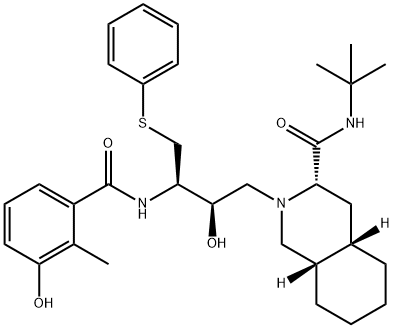- NELFINAVIR
-

- $0.00 / 1Kg/Bag
-
2025-03-07
- CAS:159989-64-7
- Min. Order: 0.1Kg/Bag
- Purity: 99% up, High Density
- Supply Ability: 20 tons
- Nelfinavir
-

- $36.00 / 1mg
-
2024-11-19
- CAS:159989-64-7
- Min. Order:
- Purity: 99.5%
- Supply Ability: 10g
- NELFINAVIR USP/EP/BP
-

- $1.10 / 1g
-
2021-07-16
- CAS:159989-64-7
- Min. Order: 1g
- Purity: 99.9%
- Supply Ability: 100 Tons Min
Related articles - Uses and side effects of Nelfinavir
- Nelfinavir is used primarily for the treatment of HIV-1 infection, but has also been recently used in patients with malignancy....
- Apr 1,2022
|
| | NELFINAVIR Basic information |
| Product Name: | NELFINAVIR | | Synonyms: | 3-isoquinolinecarboxamide,n-(1,1-dimethylethyl)decahydro-2-(2-hydroxy-3-((3-hy;8a-beta))-a-bet;nefinavir;NELFINAVIR;(3S,4aS,8aS)-N-(1,1-Dimethylethyl)decahydro-2-[(2R,3R)-2-hydroxy-3-[(3-hydroxy-2-methylbenzoyl)amino]-4-(phenylthio)butyl]-3-isoquinolinecarboxamide;Nelfinavir & Nelfinavir Mesylate;AG 1341;NELFINAVIR-12 | | CAS: | 159989-64-7 | | MF: | C32H45N3O4S | | MW: | 567.78 | | EINECS: | 1533716-785-6 | | Product Categories: | peptides | | Mol File: | 159989-64-7.mol |  |
| | NELFINAVIR Chemical Properties |
| Melting point | 185-186 °C | | Boiling point | 786.8±60.0 °C(Predicted) | | alpha | D -119.23° (c = 0.26 in methanol) | | density | 1.22±0.1 g/cm3(Predicted) | | storage temp. | under inert gas (nitrogen or Argon) at 2–8 °C | | solubility | ≥ 20.45mg/mL in Ethanol | | form | Powder | | pka | pKa1 6.0; pKa2 11.06(at 25℃) | | color | White to off-white | | Water Solubility | 7g/L(temperature not stated) |
| Toxicity | rat,LD,oral,> 5gm/kg (5000mg/kg),Toxicologist. Vol. 42, Pg. 55, 1998. |
| | NELFINAVIR Usage And Synthesis |
| Uses | Antiviral. | | Definition | ChEBI: An aryl sulfide that is used (as its mesylate salt) for treatment of HIV and also exhibits some anticancer properties. | | Indications | Nelfinavir (Viracept) is probably the most commonly
used protease inhibitor because of its low incidence of
serious adverse effects. Its most common side effects
are diarrhea and flatulence; these may resolve with continued
use. In addition to the drugs contraindicated for
use with all protease inhibitors, amiodarone, rifampin,
and quinidine are contraindicated in patients taking
nelfinavir. | | Brand name | Viracept (Agouron). | | Antimicrobial activity | Nelfinavir inhibits HIV-1 and HIV-2 proteases. Bioavailability
is affected to only a limited degree by combination with lowdose
ritonavir. | | Acquired resistance | Resistance is most frequently selected through a D30N mutation
in the HIV protease. An L90M mutation also confers
resistance. | | Pharmaceutical Applications | A synthetic chemical formulated as the mesylate for oral
administration. | | Pharmacokinetics | Oral absorption: c. 70–80% (with food)
Cmax 750 mg thrice daily: c. 3–4 mg/L
1250 mg twice daily: c. 4 mg/L
Cmin 750 mg thrice daily: c. 1–3 mg/L
1250 mg twice daily: c. 0.7–2.2 mg/L
Plasma half-life: c. 3.5 h
Volume of distribution: c. 2–7 L/kg
Plasma protein binding: >98%
Absorption and distribution
Food improves the bioavailability and the drug should be administered with a light meal. The semen:plasma ratio is 0.07. It is distributed into breast milk.
Metabolism and excretion
One major and several minor oxidative metabolites are found in plasma. Most of an oral dose is recovered in feces as unchanged drug (22%) and metabolites (78%). The remainder is recovered in urine, mainly unchanged.
An increase in the area under the time–concentration curve (AUC) has been observed in patients with hepatic impairment, but specific dose recommendations have not been made. | | Clinical Use | Treatment of HIV infection (in combination with other antiretroviral drugs) | | Side effects | The most common adverse effect is diarrhea of mild
to moderate severity. Other side effects include nausea,
fatigue, vomiting and headache. It is associated with less
dyslipidemia in comparison with ritonavir-boosted protease
inhibitors. | | Metabolism | Following oral administration, nelfinavir peak levels in plasma ranged from 0.34 mg/mL (10 mg/kg in the dog) to 1.7 mg/mL (50 mg/kg in the rat). In the dog, nelfinavir was slowly absorbed, and bioavailability was 47%. The drug appeared to be metabolized in the liver, and the major excretory route was in feces. |
| | NELFINAVIR Preparation Products And Raw materials |
|